Whether you drink it every day, or have never heard of this sweetened fermented tea, Kombucha is an amazing little powerhouse. It has the same health benefits as green tea, AND it has the added punch of being probiotic. This means it’s full of vitamins, minerals and enzymes so will help balance the good bacteria in your gut. Here, we will look in-depth at just what it is, why it’s good for you and how to make it at home, in this Ultimate Kombucha Guide.
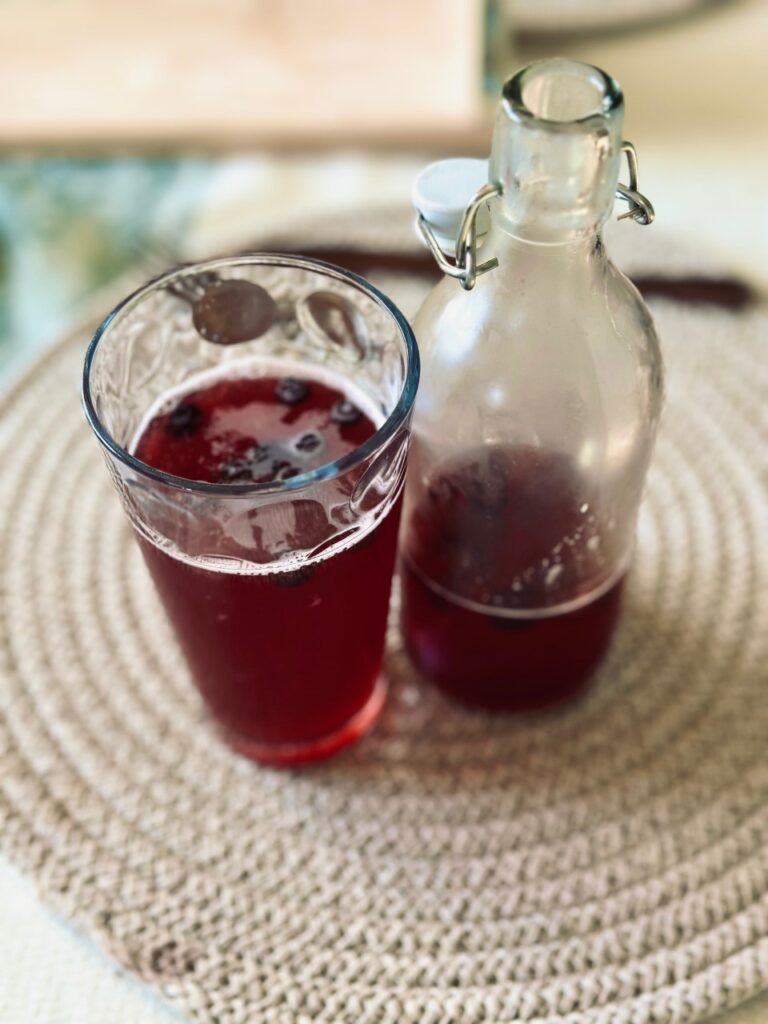
Introduction
‘What on earth is this!?’ This was my husband’s reaction to the new ‘thing’ growing in a jar on the kitchen worktop.
I told him what I would tell anyone who is new to this wonder drink, it is a little piece of (granted, ugly) magic!
Of course, it’s not magic, it is science, but Kombucha never ceases to amaze me. In this Ultimate Kombucha Guide we’re going to look at the history, the science and the uses of this refreshing drink.
Seriously though, what is it?
Kombucha is a sweetened fermented tea. It is categorized as a ‘functional beverage‘, meaning a non alcoholic drink that contains vitamins, amino acids or other nutrients associated with health benefits – (Forbes Magazine 2017)
It is made usually with black or green tea, in a double fermentation process. Tea is brewed with boiling water, and then sweetener is added. When it is cooled, a Kombucha Symbiotic Colony Of Bacteria and Yeast (SCOBY) is usually placed into the mixture, along with a small amount of liquid from a previously fermented batch. Then you leave it to ferment for a week before a second fermentation to add the bubbles.

The Ultimate Guide – The History of Kombucha
Origins
We think kombucha originated in China in around 220bc, although there is no real way of knowing for sure. Dr. Kombu, a Korean physician who brought the fermented tea to Japan as a curative for Emperor Inkyo claimed it as a longevity elixir even then. It’s believed to have made it’s way along the Silk Road with the tea it’s made with and was popular in Eastern Europe, especially rural Russia. (Encyclopaedia Britannica, 2023)
According to the Kombucha Centre, it was consumed by German and Russian POWs during WW1, From there, kombucha began to permeate various countries, playing a significant cultural role in the Westphalian industrial region of Germany. Pharmacists sold it as “Mo-Gu” (the Chinese word for “mushroom”) (Smithsonian Folklife, 2019)
In the United States, kombucha gained popularity during the HIV/AIDS epidemic, where people hoped it would help boost immune systems. It fell out of favour again though when it was reported in 1995 that there had been two cases (one fatal) of Metabolic Acidosis.
Kombucha Now
Commercially made Kombucha has a much more predictable acidic profile but pasteurization kills any of the beneficial bacteria in the drink. This renders the probiotic health benefits null and void.
With a massive swing towards understanding gut health in recent years, this beneficial beverage has made a comeback. This has led many people make this probiotic drink at home.
A huge push has been made to help people understand the importance of cleanliness and sanitation practices when we make kombucha at home. This includes sterilising equipment before using, and regularly washing hands when making ferments.
The Ultimate guide – The Science Behind Kombucha
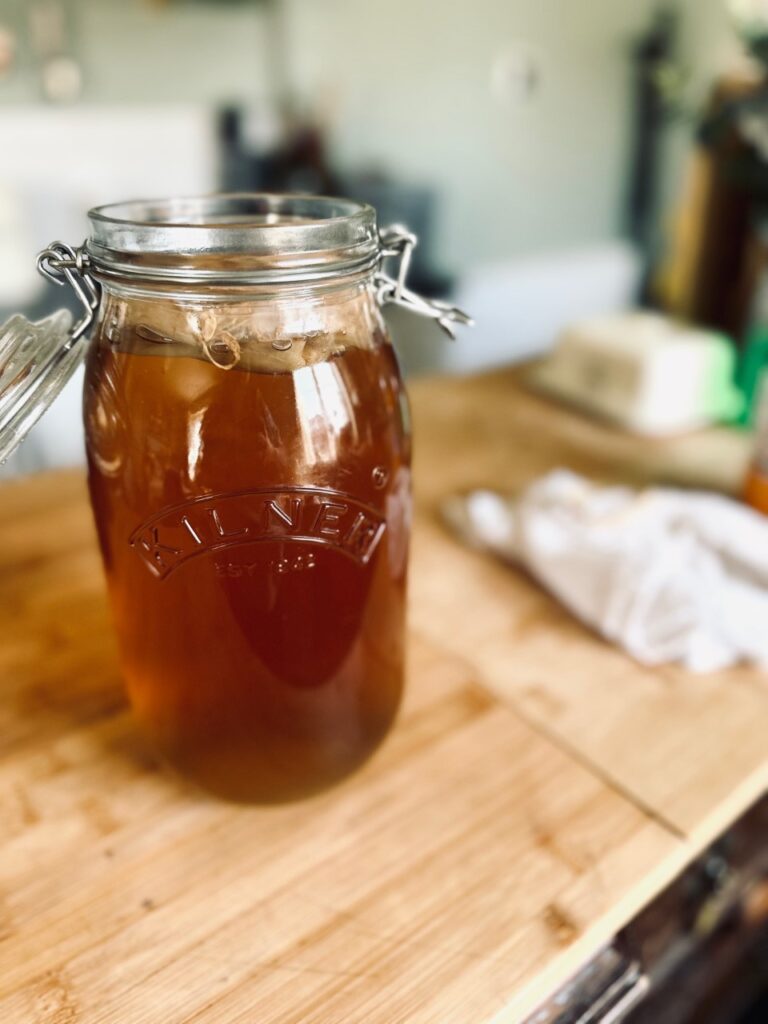
What is Fermentation?
Fermentation is the chemical process whereby suitable micro organisms break down molecules such as glucose without the presence of air (anaerobically). This produces by-products such as ethyl alcohol and carbon dioxide. So in layman’s terms, certain yeasts and bacteria eat the sugar in the tea we brew for kombucha and in doing so, they produce small amounts of alcohol, and make the tea fizzy!
It’s believed that this process has been around for over 10,000 years! Wine and beer making have been with us for a long time!! Are you surprised…?
What is a Kombucha SCOBY?
For Kombucha we use and/or make a special group of micro organisms called a SCOBY, which stands for Symbiotic Culture Of Bacteria and Yeast. As the acronym suggests, its a collection of yeast, bacteria and enzymes that digest the sugars and starches in the sweet tea we brew.
I’m not going to lie, it ain’t pretty!!! Here’s a picture of my current SCOBY that I’m using to brew about 2 litres of Kombucha.
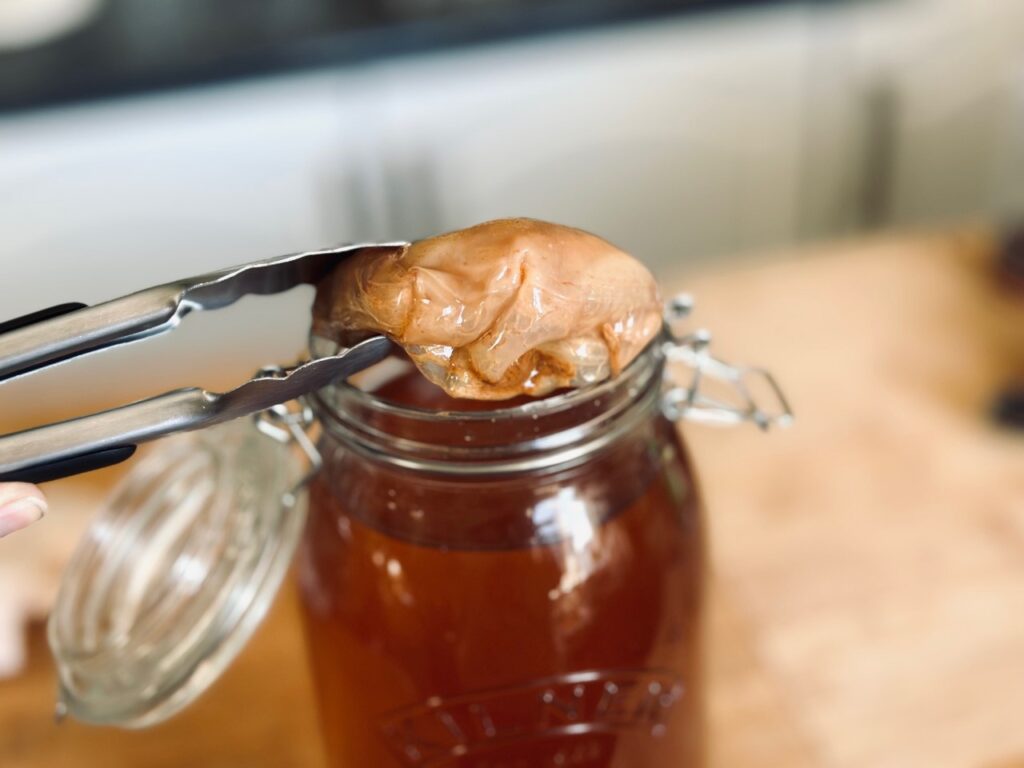
It looks like an alien!
You can understand why my husband asked what on earth it was!
The SCOBY is mainly made up of an insoluble type of fibre called cellulose, on which the yeast and bacteria live. It is rubbery, thick, and smells slightly sour (think nicely vinegared chips). If it smells bad or is visibly mouldy, then it’s time to make or purchase another ‘mother’
Kombuch SCOBYs grow, because it is a living organism, and so you can brew more and more kombucha as it does.
This also means you can give some to friends, or make a SCOBY hotel to store them!
This is simply stacking multiple SCOBYs in a jar of tea while not in use. I just think it sounds cool
How long does it take to Brew Kombucha?
As with any kind of fermentation, the frustrating answer is, it depends…however, given temperature variations, it should be about 7-10 days for a first fermentation and about the same for a second carbonation ferment.
A few notes
- Temperature – this a big factor. The fermenting tea should be be kept between 20-30c (68-80f) so warm room temp. If your kitchen is on the warm side, or its the height of summer, then the fermentation process will happen more quickly. If it’s the depths of winter, it may take longer.
- Taste – As you get to know your environment and how it affects your fermentation, you will learn how long it takes to make it just how you like it. Start tasting the Kombucha after about 6 days to see if it’s sour enough for you.
- Time – My current schedule is a Saturday Kombucha day. I brew a new batch, I bottle my last first ferment, and I transfer my bottles of second ferment to the fridge. That works for me and my family’s tastes, but you can work out a schedule to suit your own tastes, that’s the beauty of Kombucha
The Ultimate Guide – The Health Benefits of Kombucha
Looking at the effort that goes into making kombucha, you may wonder what all the fuss is about?
Why do we drink Kombucha?
Fermentation has been used for years as a way of not only preserving food that would go off otherwise, but also to increase the nutritional value of the food.
One of the biggest pluses in drinking Kombucha is that it is full of gut healthy probiotics. This has come into the mainstream health advice in recent years as a vital part of our immune system.
Probiotic health
Our gut is like a little ecosystem of it’s own, containing trillions of bacteria that help us digest food, fight of bugs and germs that we ingest, and is the primary factor in our immune health. As with any ecosystem though, it if finely balanced and what we eat and drink plays a massive part in our gut health.
The single best thing we can do for our overall health ( as well as getting enough sleep, water and sunshine) is to help out our little tummy buddies by eating and drinking good bacteria (probiotics) and then the food which keeps them healthy ( prebiotics)
This is especially important if we ever get sick and have to take antibiotics, as that will wipe out the good as well as the bad bacteria and we need those guys!!
Studies over the past decade have really established how your gut health affects:
- The immune system
- Mental health
- Cardiovascular disease
- Cancer
- Autoimmune diseases
So it’s more important than we’ve ever realised!
Tea benefits
There have been many studies on the benefits of tea, and it’s different varieties. These include:
- Immune boosting properties
- Fighting inflammation
- Improving bone health
- Fighting obesity
- Warding off cancer and heart disease
- Lowering blood pressure
These are just some of the ways that tea can help, but that’s not all.
Added Benefits
During a second fermentation, we can add fruit, juices, herbs and spices that can bring their own powerful health benefits, such as:
- Blueberries – (a current favourite) antioxidant properties
- Mint – nutrient dense, and soothing for the digestive tract
- Ginger – Healthy aging, immune boosting and antioxidant properties
There are so many flavours to try out and each will add a different dimension and benefit to your finished kombucha.
The Ultimate Guide – The Art of Brewing Kombucha
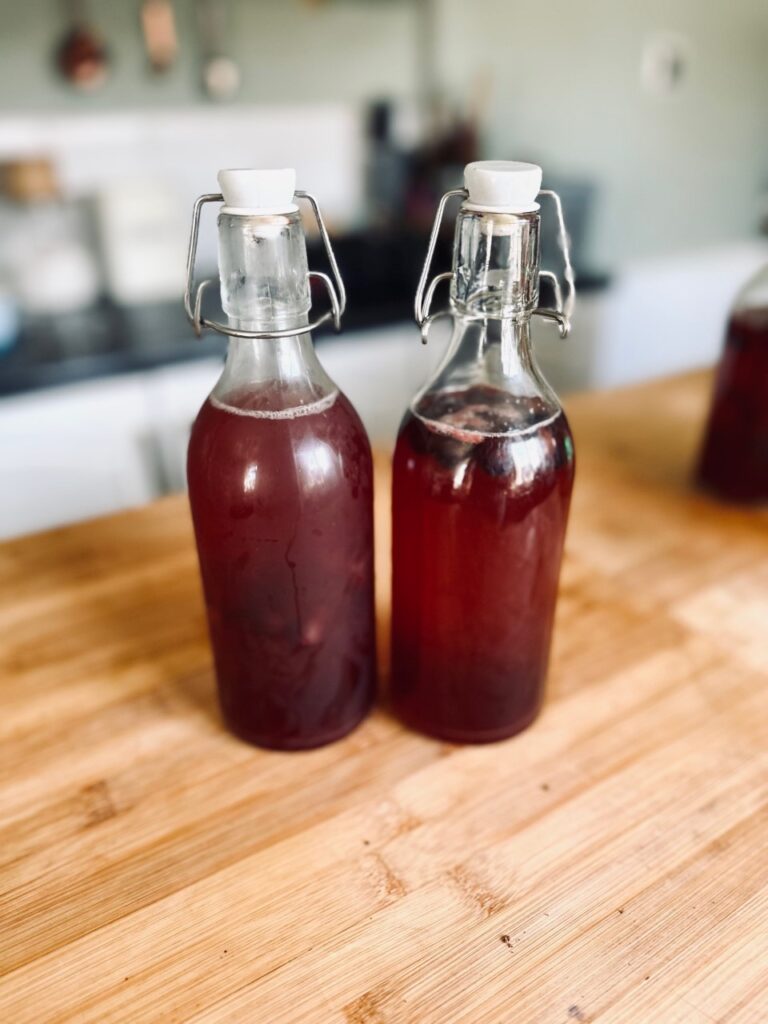
So now we are convinced it’s a great drink and the health benefits are huge. How do we make it?
Well you’re going to need a few things.
Kombucha SCOBY – how to make a SCOBY from scratch
It is possible to make your own SCOBY.
Firstly you need to find raw, unflavoured kombucha. Be careful as some shop bought Kombucha are pasturised and therefore have no live bacteria.
Mix this with 250 ml (1 cup) of green or black tea sweetened with 1–2 tablespoons of sugar.
Place the kombucha and cooled tea in a jar and cover it tightly with a coffee filter or muslin cloth.
Place the jar in a warm spot and let it ferment for up to 30 days. As the SCOBY begins to form, it will gradually become thicker and less translucent. It looks awful, bear with it, but if there is any sign of green mould, throw out and begin again.
Once the SCOBY is about 2/3-cm thick, you can use it to brew a new batch of kombucha using the following method.
What you’ll need
A saucepan (to brew the tea)
Water
Teabags or loose tea of choice ( I use this one)
Sugar
A sterilised jar or jug to ferment the tea in ( I use a large Kilner Jar like this one)
A breathable top, like a muslin cloth, a clean cotton tea towel or a coffee filter
Elastic to secure
A kombucha SCOBY (either purchased or homemade – see how to make above) plus the liquid it was stored in from the last batch
For the second fermentation:
Glass bottles with flip lids – (like these)
A Strainer
Flavouring of choice – we like blueberries, strawberries, red currents
Sugar
A funnel is very helpful
A nice alternative is this starter kit. I received this as a gift and it works great.
First Fermentation
Boil 1 lt of water in a saucepan.
When boiled, remove from the heat and add in teabags/loose tea and sugar.
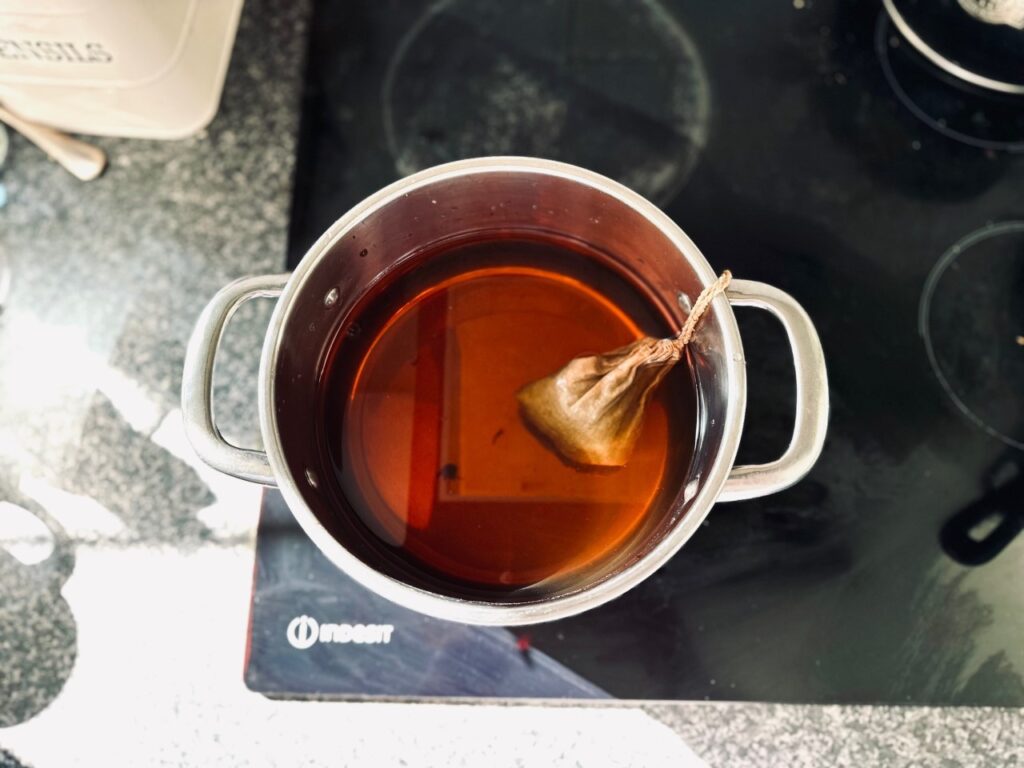
Leave this to steep for about 10 minutes.
Pour into the jar and allow to cool to room temperature. (This is important, because if the tea is too hot, it will kill the SCOBY, they like it warm not scalding.)
Once it has cooled, place the SCOBY and the liquid it was stored in into the freshly brewed tea, and cover with a muslin cloth.
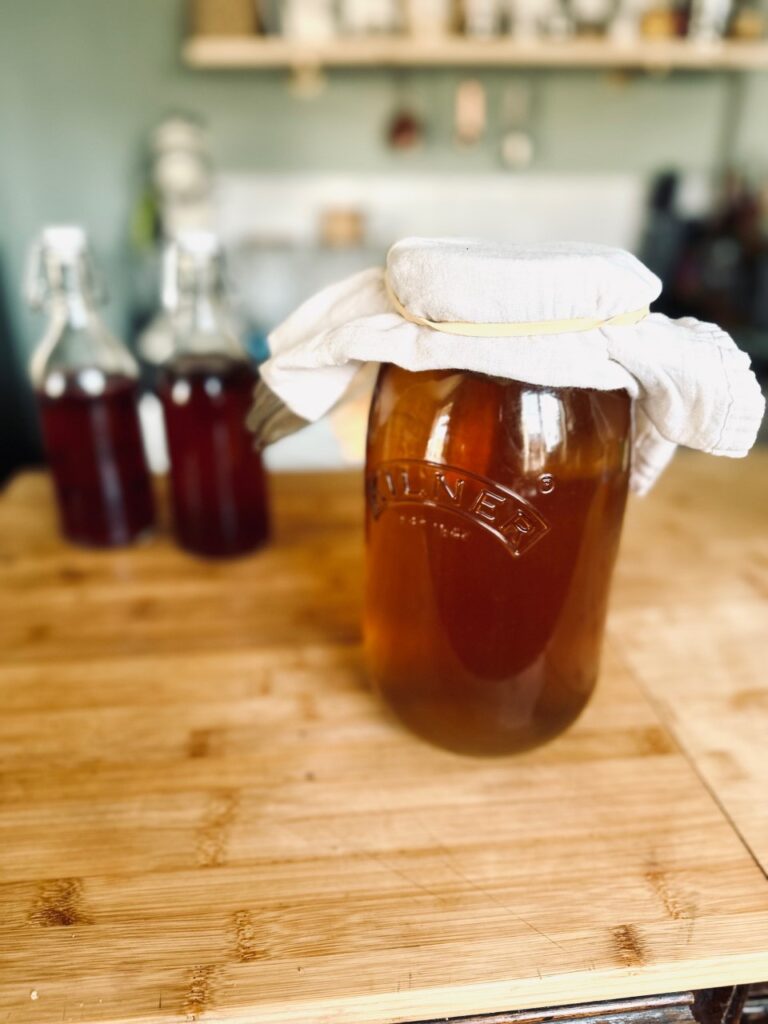
Secure with a band and set in a warm place, out of direct sunlight, for about a week.
Check from day 6 by using a sterile spoon to withdraw a small sip but do not return the used spoon to the batch, as it may contaminate it.
Once you’re happy with the tangyness (technical term!?) of the tea, it’s time for the second ferment.
Second Fermentation
I always begin by removing the SCOBY with a pair of clean tongs and placing it and some of the brewed tea into a glass container until I’m ready to use on my next brew.
Now place a strainer over a clean jug and pour liquid into the jug. this just removes any large pieces of the SCOBY strands that might have formed. (they wont hurt you, it’s just a more pleasant experience)
While that sits, prepare your bottles. If you run them through a dish washer before use they will be clean enough to use here, or else hand wash in very hot soapy water and sterilise bottles before each use.
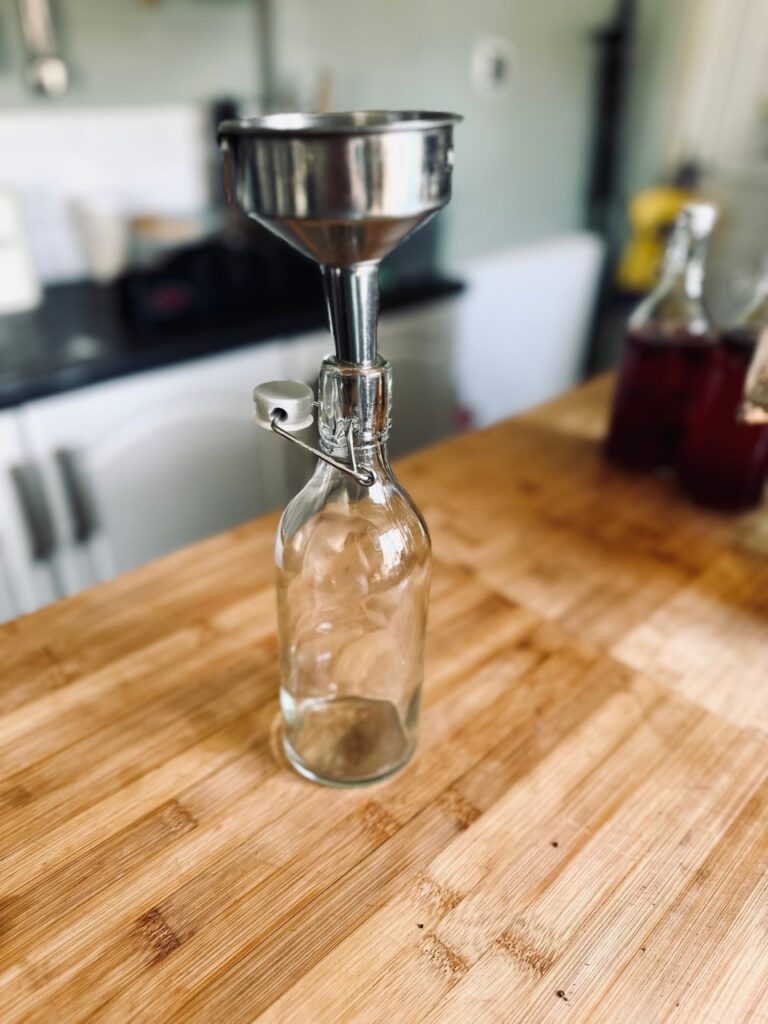
Place the fruit or flavourings in the bottle with a small amount of sugar in each one and then fill with the fermented tea. My advice would be to leave about 2 cm gap at the top before sealing so it doesn’t explode! Ask me how I know this…..
Wipe the top of the bottle with a clean cloth so the contact with the bottle top is clean, then seal the top in place.
Store in a warm dark place for 5-7 days. When you see bubbles, place in the fridge to chill and then enjoy.
Tip – open the bottle over the sink if it’s been very warm, and strain into a glass. Again, ask me how I know…:)
Some Safety Considerations with Kombucha
While Kombucha is a delicious and beneficial drink, there are always some considerations on how and who can safely consume it.
- Obviously the first precaution is around cleanliness. Always sterilise equipment you are to use for your Kombucha to avoid any contamination.
- There have been very rare cases where drinking potentially contaminated Kombucha has lead to acidosis, liver failure and allergic reactions, so it’s important to know your source.
- As it is a drink made with sugar, there are concerns that drinking too much can lead to drinking your calories. It is true that the sugars are mainly digested by the bacteria we are feeding, but it is a valid concern to be aware of.
- As it is an unpasteurised product, it can contain bacteria that would not affect a healthy person but those with a compromised immune system or cancer patients should avoid Kombucha
- It is advised that pregnant or breast feeding women avoid Kombucha because it contains small levels of caffeine and alcohol. Use your own judgement on this.
The Ultimate Guide – FAQs
What is this stuff floating in my Kombucha?
As the SCOBY ferments the tea, it produces after it’s own kind. This means it’s making more good bacteria and enzymes, multiplying. This is just new, extra good bits! It is perfectly safe to consume, but if it’s just too yucky, then strain the drink first.
Why isn’t my Kombucha fizzy?
– For the most part, carbonation happens in the second ferment. If you’ve only brewed it with the mother, it may not have had the air tight conditions to create the carbon dioxide given off as the bacteria eat the sugar. Give your Kombucha a second ferment.
If you’ve done your second ferment and it’s just still not fizzy, try adding a little extra sugar in with the fruit, to give the live creatures something more to eat. Start with a little and add more next time, until you get the fizz you want without it exploding! This really is less is more, trust me.
How long does it take to get fizzy?
– Again, depending on temperature, anywhere from 4-7 days. Keep an eye out for bubbles on the top that fizz when moved slightly. Although don’t shake it, it may burst open when you open it. Or before..
How can I tell if my Kombucha is bad?
– The big two are smell and look. Kombucha is supposed to smell mildly sour, a bit like faint vinegar. If it smells really foul or just off, then trust your gut and don’t use it. Similarly, Scobys are not pretty and are brown and gummy, but if they are green or pink and smell gross, then start again.
Why does my Kombucha smell funny?
-The finished Kombucha should smell mildly both sweet and sour, and of course of any flavourings you’ve added. If it smells foul then work backwards and check bottles, for missed debris, and then the mother for signs of being off.
What should Kombucha smell like?
– It’s a hard one to explain, but should smell slightly sour, like a faint or very weak vinegar, but with a sweet smell too. The longer it is fermented, the stronger the sour smell will get. This is a matter of taste, because some people love a really sour Kombucha. If not, bottle when your desired tartness is reached.
How do I know if I killed my SCOBY?
– A dead SCOBY is black, so it’s easy to tell. A SCOBY is usually a brownish smooth rubbery object. If it is any other colour, it might be on the way out. Any white fuzzy spots are mould, but as the liquid is quite acidic, it’s less common to find mould.
What if I accidently swallow some SCOBY?
– Rejoice! Your gut will thank you! It won’t hurt at all to swallow some of the stringy bits that form during fermentation, but if it grosses you out, strain through a muslin cloth before drinking and you should get it all that way.
What do I do with my old SCOBY?
– Throw it on your compost pile!! It will break down and add diversity to your garden and feed you in a different way. If you must, throw it in your waste disposal, or in your recycling compost bin.
What do I do with my SCOBY if I don’t want to make Kombucha straight away?
– Store your SCOBY in some liquid from your last batch and put an lid on, and it will keep at room temperature for a couple of weeks. More than that and you can put it in the fridge until you’re ready to go again.
The Ultimate Guide – Beyond Kombucha: Other Ferments
Kombucha does not stand alone as the only ferment on the planet, as I’m sure you know, but where do we go from here?
Studies have shown that combining fermented foods and varying what you eat and drink will populate your gut with a variety of beneficial bacteria that are strong and robust.
Other ferments to try:
- Yoghurt – Obviously a familiar one, live yoghurt can be used so many ways; add to smoothies, top granola with yoghurt for a tasty breakfast, mix with fruit puree and freeze for a refreshing summer treat, or make a yummy dip/dressing for veggies or salad.
- Kefir – There are two types of Kefir; milk kefir and water kefir. Similar to Kombucha, you use a ‘mother’ or in this case, Kefir grains ( water kefir grains are different from milk kefir grains so cannot be used interchangeably). Milk kefir is a yoghurt drink, similar to the little pots you can buy in the shop of probiotic yoghurt drink… and water kefir is a fizzy probiotic drink, not dissimilar to kombucha, just made with water rather than tea. You then flavour in the second fermentation.
- Sauerkraut – A tangy flavoured cabbage dish. Lacto-fermented Sauerkraut is great with sandwiches or cheese boards, on top of tacos, as a side for chicken, basically with anything savoury!! It can be more than just cabbage too. I prefer Cortido which is just cabbage sauerkraut with onion and carrot added.
- Kimchi – A lot of people have heard of Kimchi. It is a vamped up Korean Sauerkraut usually with fish paste and it’s quite spicy.
- Lacto-fermented vegetables – Think pickles, onions, hot sauce, all yummy, all the same process.
- Sourdough – of course, no list would be complete without good ole Sourdough! There are plenty of ways to incorporate sourdough into your diet, for improved digestion, and if you want to know how to make a sourdough started from scratch, check out my post here.
Conclusion
Ferments are so good for our gut microbiome, as we have seen. They increase good bacteria, improve our immune system and help us fight disease and inflammation. They help us preserve food to decrease food wastage, and taste soooo good.
Kombucha is a great way to dip your toe into fermenting because you can pretty easily tell if it is going wrong! Then all you’ve wasted is a cup of tea. Experimenting with various flavours and infusions as we come to the summer months is exciting. Also, sharing it with family and friends is a great way to introduce them to probiotic drinks.
I hope you’ve enjoyed this deep dive into all things Kombucha, in our Ultimate Guide to Kombucha. Let me know in the comments what your favourite flavour combinations are, I’m always up for trying a new flavour! Thanks friends x



2 thoughts on “The Ultimate Kombucha Guide”